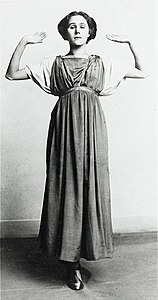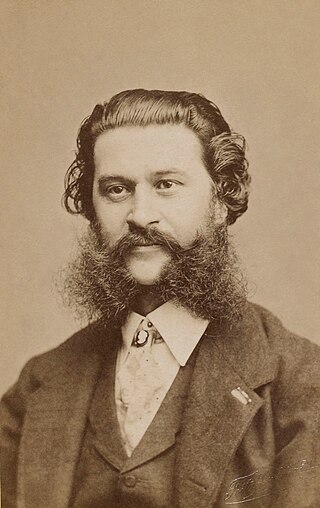
Johann Baptist Strauss II, also known as Johann Strauss Jr., the Younger or the Son, was an Austrian composer of light music, particularly dance music and operettas as well as a violinist. He composed over 500 waltzes, polkas, quadrilles, and other types of dance music, as well as several operettas and a ballet. In his lifetime, he was known as "The Waltz King", and was largely responsible for the popularity of the waltz in Vienna during the 19th century. Some of Johann Strauss's most famous works include "The Blue Danube", "Kaiser-Walzer", "Tales from the Vienna Woods", "Frühlingsstimmen", and the "Tritsch-Tratsch-Polka". Among his operettas, Die Fledermaus and Der Zigeunerbaron are the best known.
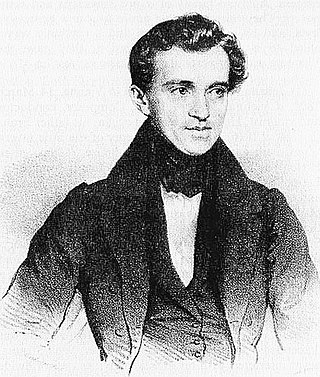
Johann Baptist Strauss I, also known as Johann Strauss Sr., the Elder or the Father, was an Austrian composer of the Romantic Period. He was famous for his light music, namely waltzes, polkas, and galops, which he popularized alongside Joseph Lanner, thereby setting the foundations for his sons—Johann, Josef and Eduard—to carry on his musical dynasty. He is best known for his composition of the Radetzky March.

The Vienna New Year's Concert is an annual concert of classical music performed by the Vienna Philharmonic on the morning of New Year's Day in Vienna, Austria. The concert occurs at the Musikverein at 11:15. The orchestra performs the same concert programme on 30 December, 31 December, and 1 January but only the last concert is regularly broadcast on radio and television.

The Vienna State Opera is a historic opera house and opera company based in Vienna, Austria. The 1,709-seat Renaissance Revival venue was the first major building on the Vienna Ring Road. It was built from 1861 to 1869 following plans by August Sicard von Sicardsburg and Eduard van der Nüll, and designs by Josef Hlávka. The opera house was inaugurated as the "Vienna Court Opera" in the presence of Emperor Franz Joseph I and Empress Elisabeth of Austria. It became known by its current name after the establishment of the First Austrian Republic in 1921. The Vienna State Opera is the successor of the old Vienna Court Opera. The new site was chosen and the construction paid by Emperor Franz Joseph in 1861.

Josef Strauss was an Austrian composer.

Franz Schreker was an Austrian composer, conductor, librettist, teacher and administrator. Primarily a composer of operas, Schreker developed a style characterized by aesthetic plurality, timbral experimentation, strategies of extended tonality and conception of total music theatre into the narrative of 20th-century music.
Aschenbrödel (Cinderella) is a ballet written by Johann Strauss II. He had written all the principal parts of the ballet, and was intending to fill in the orchestration as time permitted. However, Strauss died in 1899, and it was finished by composer Josef Bayer in 1900.

Robert Elisabeth Stolz was an Austrian songwriter and conductor as well as a composer of operettas and film music.

Alfred Grünfeld was an Austrian pianist and composer.
Clemens Erwein Heinrich Karl Bonaventura Freiherr von und zu Franckenstein was a German opera composer.

Franz Salmhofer was an Austrian composer, clarinetist and conductor. He studied the clarinet, composition and musicology in Vienna. Salmhofer served successively as Kapellmeister of the Burgtheater, Director of the Vienna State Opera and Director of the Vienna Volksoper and composed a number of works, few of which are played today.
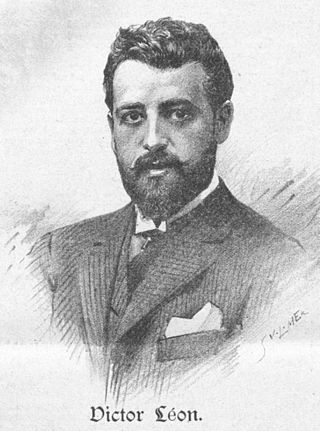
Victor Léon, also Viktor Léon was a well-known Jewish Austrian-Hungarian librettist. He collaborated with Leo Stein to produce the libretto of Franz Lehár's romantic operetta The Merry Widow.
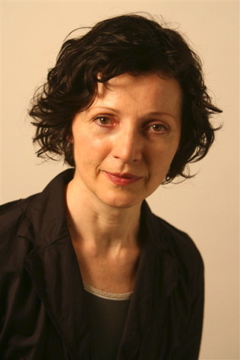
Andrea Amort is an Austrian dance critic, dance historian, playwright, festival and exhibition curator as well as a non-fiction writer.

Hanna Berger was an Austrian dancer, choreographer, teacher, director, theatre director, writer and lifelong anti-Nazi and communist. She was described as part of the free dance movement.
Jennifer Holloway is an American operatic mezzo-soprano and soprano who has made an international career performing at leading opera houses and festivals. She began as a mezzo-soprano singing roles such as Adalgisa in Bellini's Norma, and moved to soprano roles such as Salome and Grete Graumann in Schreker's Der ferne Klang.
Gösta Neuwirth is an Austrian musicologist, composer and academic teacher. He studied in Vienna and Berlin, where he wrote a dissertation on harmony in Franz Schreker's Der ferne Klang. He has taught at universities and music schools including the Musikhochschule Graz, University of Graz, Hochschule der Künste Berlin and University of Freiburg. His compositions include a string quartet and a chamber opera.

Enid Szánthó was a Hungarian operatic contralto. From 1928, she belonged to the ensemble of the Vienna State Opera and appeared at the Bayreuth Festival from 1930, first as Erda in Der Ring des Nibelungen. She gave guest performances in opera and concert in Florence, London, Berlin, Paris, and New York at the Metropolitan Opera, where she made her debut as Fricka in 1938. Her career was de facto ended later that year when Austria came under the Nazi regime.
Der Geburtstag der Infantin is a “dance-pantomime” in one act by Austrian composer Franz Schreker, based on the Oscar Wilde novella The Birthday of the Infanta.
Roman Sadnik is an Austrian operatic tenor.
Lili Hutterstrasser-Scheidl was an Austrian composer, known by the pseudonym Lio Hans. Her opera Maria von Magdala was performed at the Vienna Volksoper on 22 December 1919, and was the only musical stage work by a female composer to be performed in Austria in the 20th century until Olga Neuwirth's Bählamms Fest in 1999.

